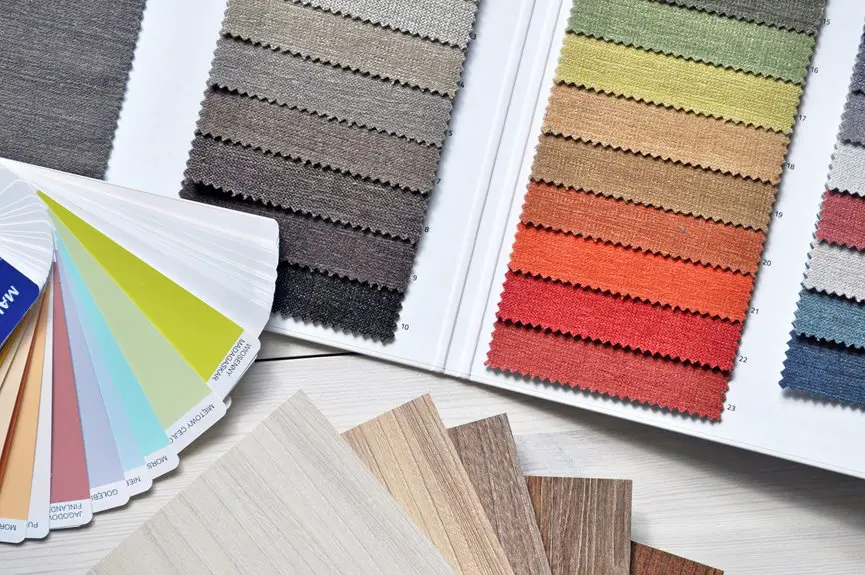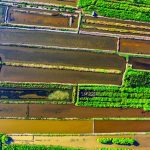Nonwoven geotextiles are made from synthetic fibers like polypropylene, bonded into a durable, flexible web that resists rot and chemicals. You’ll benefit from improved soil stability, erosion control, and effective drainage in your projects. They’re lightweight, easy to install, and great for roads, landscaping, and drainage systems. If you’re weighing options, nonwoven fabrics offer better filtration and puncture resistance compared to woven ones. If you want to fully understand their uses and installation, there’s more to explore.
Table of Contents
Key Takeaways
- Nonwoven geotextiles are made from synthetic fibers bonded into a web-like structure for strength and flexibility.
- They enhance soil stability, prevent erosion, and promote effective drainage through filtration.
- Commonly used in road construction, erosion control, drainage systems, and landscaping for durability and versatility.
- Installation requires a clean, level surface, overlapping sheets by 12 inches, and securing edges to maintain fabric integrity.
- Compared to woven geotextiles, nonwoven offers better drainage and flexibility but less tensile strength.
What Are Nonwoven Geotextiles Made Of?
Nonwoven geotextiles consist primarily of synthetic fibers like polypropylene or polyester, which manufacturers bond together through heat, chemicals, or mechanical processes.
Nonwoven geotextiles are made by bonding synthetic fibers like polypropylene or polyester using heat, chemicals, or mechanical methods.
When you look closely, these fibers form a tangled, web-like structure rather than woven threads, giving the material its unique properties.
You’ll find that the bonding methods impact the geotextile’s strength and flexibility, so manufacturers choose them based on the intended application.
The synthetic nature of polypropylene and polyester guarantees resistance to rot, mildew, and chemical degradation, which is critical for durability in harsh environments.
You’ll also notice that these fibers vary in thickness and weight, allowing you to select geotextiles tailored to different project demands, such as drainage or soil stabilization.
This composition makes nonwoven geotextiles versatile and reliable in civil engineering and landscaping projects.
Key Benefits of Using Nonwoven Geotextiles
Although you mightn’t see them every day, these geotextiles offer significant advantages in construction and landscaping projects.
You’ll appreciate their ability to improve soil stability, which helps prevent erosion and maintain structural integrity. Nonwoven geotextiles also promote effective drainage by allowing water to pass while filtering out soil particles. This means you can avoid waterlogging and reduce pressure on structures.
Their durability guarantees long-term performance, resisting degradation from environmental factors. Plus, they’re lightweight and easy to handle, saving you time during installation.
Common Applications in Construction and Landscaping
When you’re managing construction or landscaping projects, choosing the right materials can make all the difference. Nonwoven geotextiles offer versatility, helping you improve soil stability, drainage, and erosion control. You can use them in various ways to enhance project durability and performance.
Here are some common applications:
| Application | Purpose |
|---|---|
| Road Construction | Separation and reinforcement |
| Erosion Control | Soil stabilization |
| Drainage Systems | Filtration and water flow |
| Landscaping | Weed barrier and soil protection |
How to Properly Install Nonwoven Geotextiles
Before laying down geotextiles, you’ll want to prepare the site by clearing debris and leveling the ground to guarantee proper installation.
Next, roll out the nonwoven geotextile carefully, making certain it lies flat without wrinkles or folds. Overlap adjacent sheets by at least 12 inches to maintain continuous coverage and prevent soil migration.
Secure the fabric with stakes or pins along the edges and overlaps to keep it in place during backfilling. When covering the geotextile with soil or aggregate, avoid sharp or heavy objects that could tear the material.
Finally, compact the fill gently to maintain the fabric’s integrity and effectiveness. Following these steps ensures your nonwoven geotextile performs at its best in drainage, filtration, or separation applications.
Comparing Nonwoven and Woven Geotextiles: Which One to Choose?
How do you decide between nonwoven and woven geotextiles for your project? It depends on your specific needs.
Nonwoven geotextiles offer excellent filtration and drainage due to their porous structure, making them ideal for erosion control and soil stabilization. They’re also more flexible and puncture-resistant.
On the other hand, woven geotextiles provide superior strength and durability, perfect for reinforcement and separation in heavy-load applications like road construction.
If you need soil separation or reinforcement, woven might be your best bet. But if drainage and filtration are critical, nonwoven is usually the way to go.
Consider your project’s load requirements, soil type, and drainage needs to make the right choice. Understanding these differences guarantees you pick the geotextile that performs best.
Frequently Asked Questions
How Long Do Nonwoven Geotextiles Typically Last Underground?
You can expect nonwoven geotextiles to last underground anywhere from 10 to 50 years, depending on factors like soil conditions, exposure to UV light, and the specific material used in the fabric’s construction.
Can Nonwoven Geotextiles Be Recycled or Reused?
Recycling nonwoven geotextiles isn’t a walk in the park, but you can reuse them in less demanding projects. You’ll find their durability fades after use, so recycling options remain limited but evolving with new tech.
Are Nonwoven Geotextiles Environmentally Friendly?
You’ll find nonwoven geotextiles environmentally friendly since they prevent soil erosion and promote drainage, reducing environmental damage. Plus, many are made from recycled materials, helping you support sustainability while meeting your project’s needs effectively.
What Are the Cost Differences Between Nonwoven and Woven Geotextiles?
Think of woven geotextiles like a sturdy woven basket—they usually cost more due to durability. Nonwoven ones, like a soft blanket, are cheaper but less strong. You’ll pay more for woven’s strength and longevity.
How Do Weather Conditions Affect the Performance of Nonwoven Geotextiles?
You’ll find nonwoven geotextiles perform differently under various weather conditions; extreme heat can degrade fibers, while heavy rain may clog pores, reducing drainage efficiency. UV exposure also weakens them unless they’re treated for protection.
- The Use of Nonwovens in Construction and Civil Engineering - July 11, 2025
- The Use of Nonwovens in Construction and Civil Engineering - July 11, 2025
- The Use of Nonwovens in Construction and Civil Engineering - July 11, 2025







